Loading... ## 学习目标 - 基于SpringBoot框架的程序开发步骤 - 熟练使用SpringBoot配置信息修改服务器配置 - 基于SpringBoot的完成SSM整合项目开发 ## 一、SpringBoot简介 ### 1. 入门案例 #### 问题导入 SpringMVC的HelloWord程序大家还记得吗? - SpringBoot是由Pivotal团队提供的全新框架,其设计目的是用来简化Spring应用的初始搭建以及开发过程 - 原生开发SpringMVC程序过程 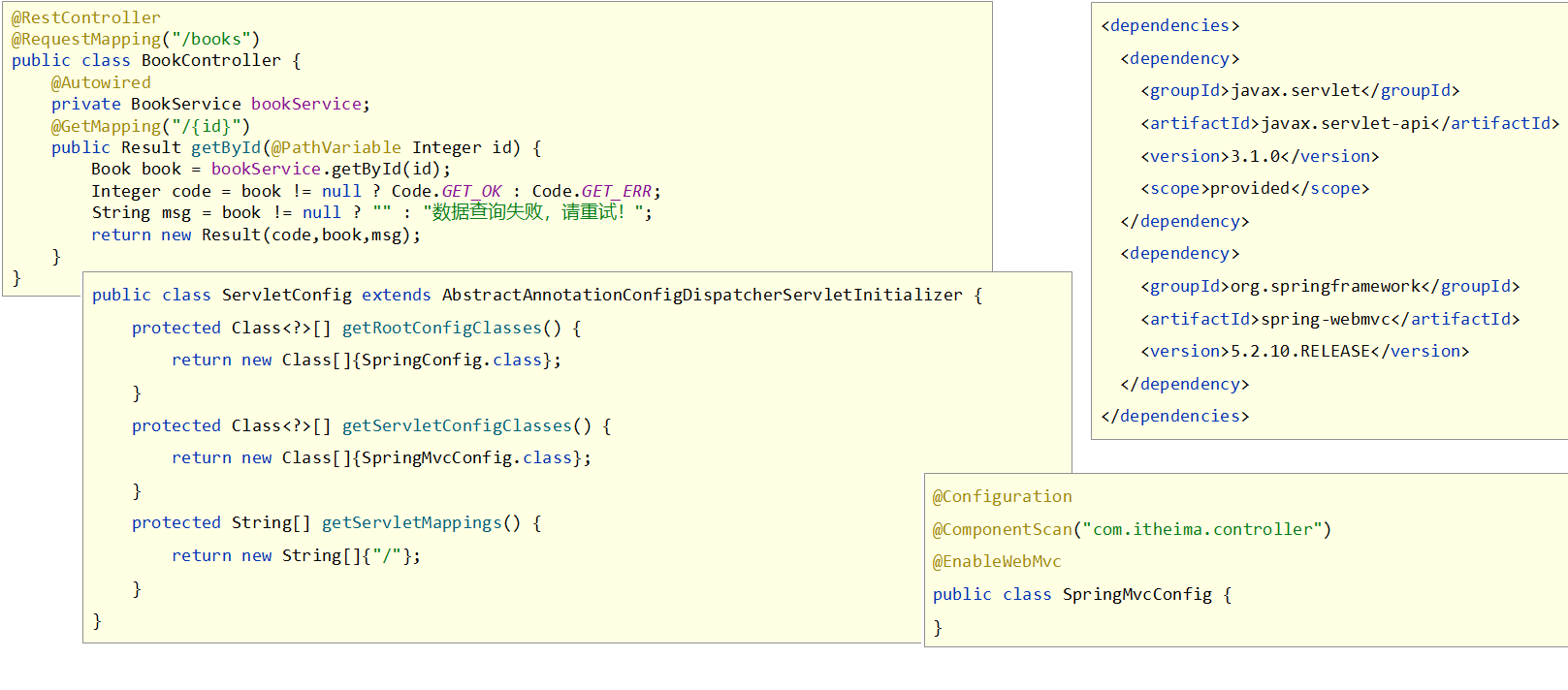 #### 1.1 入门案例开发步骤 ①:创建新模块,选择Spring初始化,并配置模块相关基础信息 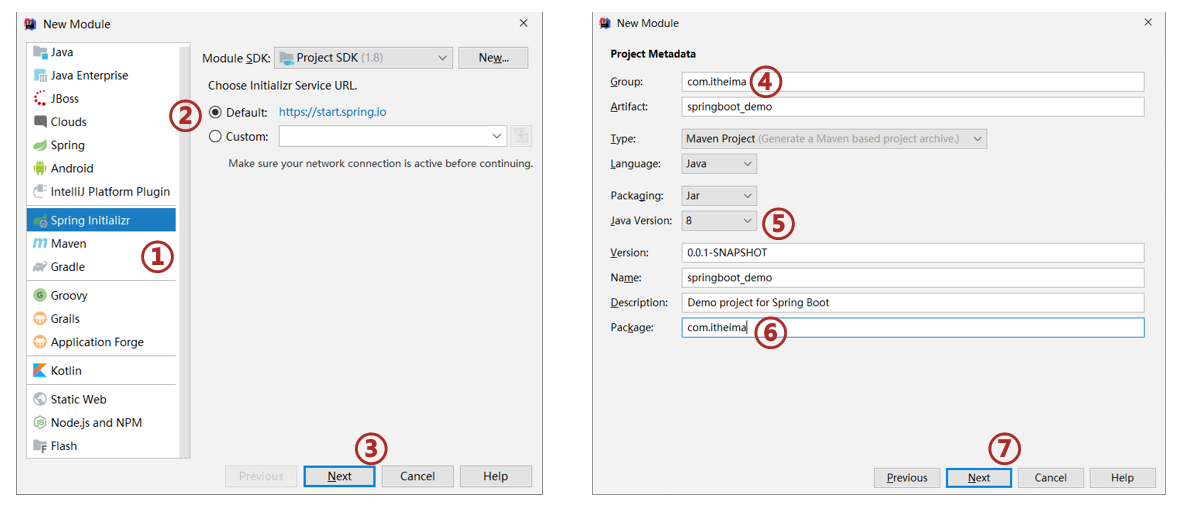 ②:选择当前模块需要使用的技术集  ③:开发控制器类 ```java @RestController @RequestMapping("/books") public class BookController { @GetMapping("/{id}") public String getById(@PathVariable Integer id) { System.out.println("id ==> " + id); return "hello , spring boot! "; } } ``` ④:运行自动生成的Application类  - 最简SpringBoot程序所包含的基础文件 ```xml <?xml version="1.0" encoding="UTF-8"?> <project xmlns="http://maven.apache.org/POM/4.0.0" xmlns:xsi="http://www.w3.org/2001/XMLSchema-instance" xsi:schemaLocation="http://maven.apache.org/POM/4.0.0 https://maven.apache.org/xsd/maven-4.0.0.xsd"> <modelVersion>4.0.0</modelVersion> <parent> <groupId>org.springframework.boot</groupId> <artifactId>spring-boot-starter-parent</artifactId> <version>2.5.0</version> </parent> <groupId>com.itheima</groupId> <artifactId>springboot-01-quickstart</artifactId> <version>0.0.1-SNAPSHOT</version> <dependencies> <dependency> <groupId>org.springframework.boot</groupId> <artifactId>spring-boot-starter-web</artifactId> </dependency> </dependencies> </project> ``` ```java @SpringBootApplication public class Application { public static void main(String[] args) { SpringApplication.run(Application.class, args); } } ``` - Spring程序与SpringBoot程序对比  **注意事项:** **基于idea开发SpringBoot程序需要确保联网且能够加载到程序框架结构** #### 1.2 基于SpringBoot官网创建项目  #### 1.3 SpringBoot项目快速启动 ① 对SpringBoot项目打包(执行Maven构建指令package) ② 执行启动指令 ```cmd java -jar springboot_01_quickstart.jar # 项目的名称根据实际情况修改 ``` **注意事项:** **jar支持命令行启动需要依赖maven插件支持,请确认打包时是否具有SpringBoot对应的maven插件。** ```xml <build> <plugins> <plugin> <groupId>org.springframework.boot</groupId> <artifactId>spring-boot-maven-plugin</artifactId> </plugin> </plugins> </build> ``` ### 2. SpringBoot概述 #### 问题导入 学习了SpringBoot入门案例之后,感觉对比SpringMVC哪一个更加方便简洁? - SpringBoot是由Pivotal团队提供的全新框架,其设计目的是用来**简化**Spring应用的**初始搭建**以及**开发过程** - Spring程序缺点 - 配置繁琐 - 依赖设置繁琐 - SpringBoot程序优点 - 自动配置 - 起步依赖(简化依赖配置) - 辅助功能(内置服务器,……) #### 2.1 起步依赖 - starter - SpringBoot中常见项目名称,定义了当前项目使用的所有项目坐标,以达到减少依赖配置的目的 ```xml <?xml version="1.0" encoding="UTF-8"?> <project xmlns="http://maven.apache.org/POM/4.0.0" xmlns:xsi="http://www.w3.org/2001/XMLSchema-instance" xsi:schemaLocation="http://maven.apache.org/POM/4.0.0 https://maven.apache.org/xsd/maven-4.0.0.xsd"> <modelVersion>4.0.0</modelVersion> <parent> <groupId>org.springframework.boot</groupId> <artifactId>spring-boot-starter-parent</artifactId> <version>2.5.0</version> </parent> <groupId>com.itheima</groupId> <artifactId>springboot-01-quickstart</artifactId> <version>0.0.1-SNAPSHOT</version> <dependencies> <dependency> <groupId>org.springframework.boot</groupId> <artifactId>spring-boot-starter-web</artifactId> </dependency> </dependencies> </project> ``` ```xml <project xmlns="http://maven.apache.org/POM/4.0.0" xsi:schemaLocation="http://maven.apache.org/POM/4.0.0 http://maven.apache.org/xsd/maven-4.0.0.xsd" xmlns:xsi="http://www.w3.org/2001/XMLSchema-instance"> <modelVersion>4.0.0</modelVersion> <groupId>org.springframework.boot</groupId> <artifactId>spring-boot-dependencies</artifactId> <version>2.5.0</version> <packaging>pom</packaging> <properties> <servlet-api.version>4.0.1</servlet-api.version> ... </properties> </project> ``` - parent - 所有SpringBoot项目要继承的项目,定义了若干个坐标版本号(依赖管理,而非依赖),以达到减少依赖冲突的目的 - spring-boot-starter-parent(2.5.0)与 spring-boot-starter-parent(2.4.6)共计57处坐标版本不同 ```xml <?xml version="1.0" encoding="UTF-8"?> <project xmlns="http://maven.apache.org/POM/4.0.0" xsi:schemaLocation="http://maven.apache.org/POM/4.0.0 http://maven.apache.org/xsd/maven-4.0.0.xsd" xmlns:xsi="http://www.w3.org/2001/XMLSchema-instance"> <modelVersion>4.0.0</modelVersion> <parent> <groupId>org.springframework.boot</groupId> <artifactId>spring-boot-dependencies</artifactId> <version>2.5.0</version> </parent> <artifactId>spring-boot-starter-parent</artifactId> <packaging>pom</packaging> ... </project> ``` - 实际开发 - 使用任意坐标时,仅书写GAV中的G和A,V由SpringBoot提供 - 如发生坐标错误,再指定version(要小心版本冲突) ```xml <dependency> <groupId>junit</groupId> <artifactId>junit</artifactId> <version>${junit.version}</version> </dependency> <dependency> <groupId>javax.servlet</groupId> <artifactId>javax.servlet-api</artifactId> <version>${servlet-api.version}</version> </dependency> ``` ```xml <?xml version="1.0" encoding="UTF-8"?> <project xmlns="http://maven.apache.org/POM/4.0.0" xmlns:xsi="http://www.w3.org/2001/XMLSchema-instance" xsi:schemaLocation="http://maven.apache.org/POM/4.0.0 https://maven.apache.org/xsd/maven-4.0.0.xsd"> <parent> <groupId>org.springframework.boot</groupId> <artifactId>spring-boot-starter-parent</artifactId> <version>2.5.0</version> </parent> <dependencies> <dependency> <groupId>org.springframework.boot</groupId> <artifactId>spring-boot-starter-web</artifactId> </dependency> <dependency> <groupId>org.springframework.boot</groupId> <artifactId>spring-boot-starter-test</artifactId> <scope>test</scope> </dependency> </dependencies> </project> ``` #### 2.2 辅助功能 - SpringBoot程序启动 ```java @SpringBootApplication public class Springboot01QuickstartApplication { public static void main(String[] args) { SpringApplication.run(Springboot01QuickstartApplication.class, args); } } ``` - SpringBoot在创建项目时,采用jar的打包方式 - SpringBoot的引导类是项目的入口,运行main方法就可以启动项目 - 使用maven依赖管理变更起步依赖项 - Jetty比Tomcat更轻量级,可扩展性更强(相较于Tomcat),谷歌应用引擎(GAE)已经全面切换为Jetty ```xml <dependencies> <dependency> <groupId>org.springframework.boot</groupId> <artifactId>spring-boot-starter-web</artifactId> <!--web起步依赖环境中,排除Tomcat起步依赖--> <exclusions> <exclusion> <groupId>org.springframework.boot</groupId> <artifactId>spring-boot-starter-tomcat</artifactId> </exclusion> </exclusions> </dependency> <!--添加Jetty起步依赖,版本由SpringBoot的starter控制--> <dependency> <groupId>org.springframework.boot</groupId> <artifactId>spring-boot-starter-jetty</artifactId> </dependency> </dependencies> ``` ## 二、基础配置 ### 1. 配置文件格式 #### 问题导入 框架常见的配置文件有哪几种形式? #### 1.1 修改服务器端口 http://localhost:8080/books/1 >>> http://localhost/books/1 SpringBoot提供了多种属性配置方式 - application.properties ```properties server.port=80 ``` - application.yml ```yaml server: port: 81 ``` - application.yaml ```yaml server: port: 82 ``` #### 1.2 自动提示功能消失解决方案 操作步骤: 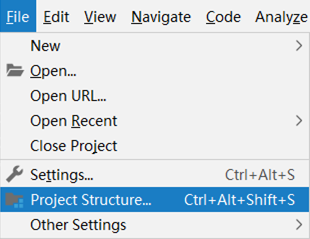 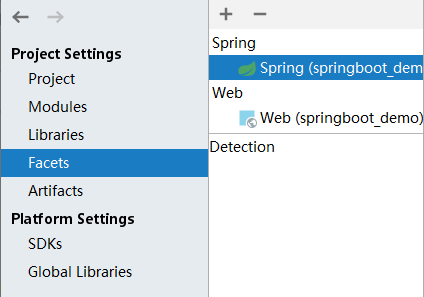 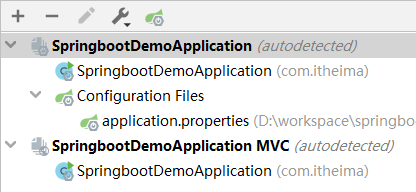  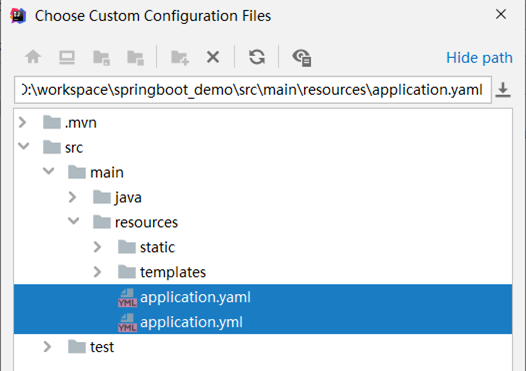 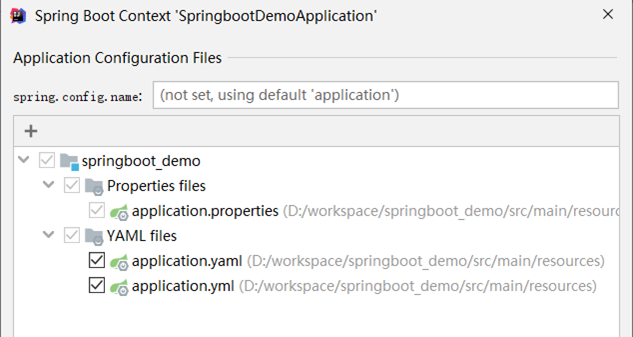 #### 1.3 SpringBoot配置文件加载顺序(了解) - application.**properties** > application.**yml** > application.**yaml** **注意事项:** 1. **SpringBoot核心配置文件名为application** 2. **SpringBoot内置属性过多,且所有属性集中在一起修改,在使用时,通过提示键+关键字修改属性** ### 2. yaml #### 问题导入 什么是yaml,和properties有什么区别? - YAML(YAML Ain't Markup Language),一种数据序列化格式 - 优点: - 容易阅读 - 容易与脚本语言交互 - 以数据为核心,重数据轻格式 - YAML文件扩展名 - .yml(主流) - .yaml #### 2.1 yaml语法规则 - 大小写敏感 - 属性层级关系使用多行描述,每行结尾使用冒号结束 - 使用缩进表示层级关系,同层级左侧对齐,只允许使用空格(不允许使用Tab键) - 属性值前面添加空格(属性名与属性值之间使用冒号+空格作为分隔) - `#`表示注释 - 核心规则:**数据前面要加空格与冒号隔开** #### 2.2 yaml数组数据 - 数组数据在数据书写位置的下方使用减号作为数据开始符号,每行书写一个数据,减号与数据间空格分隔 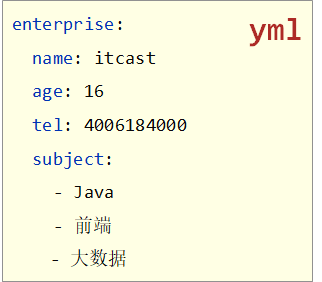 #### 2.3 yaml数据读取 - 使用@Value读取单个数据,属性名引用方式:${一级属性名.二级属性名……} 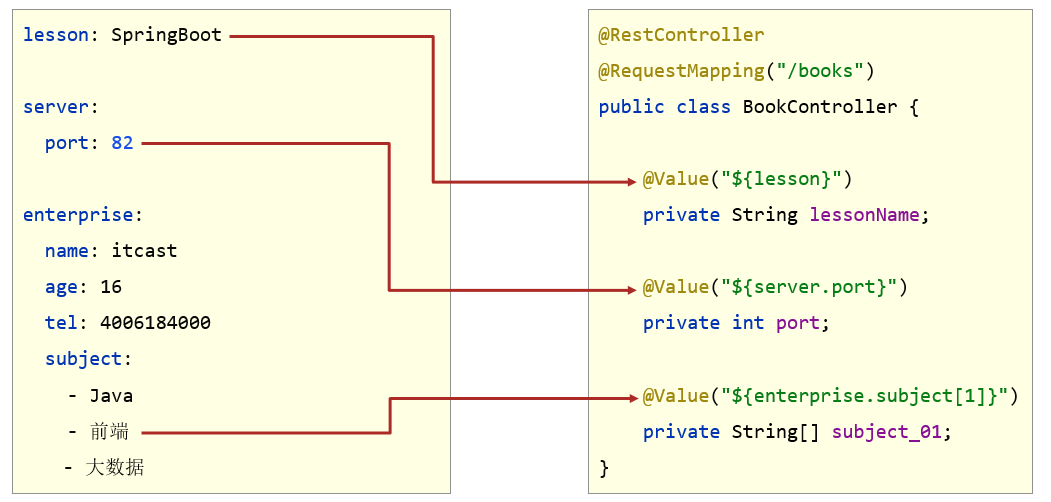 - 封装全部数据到Environment对象 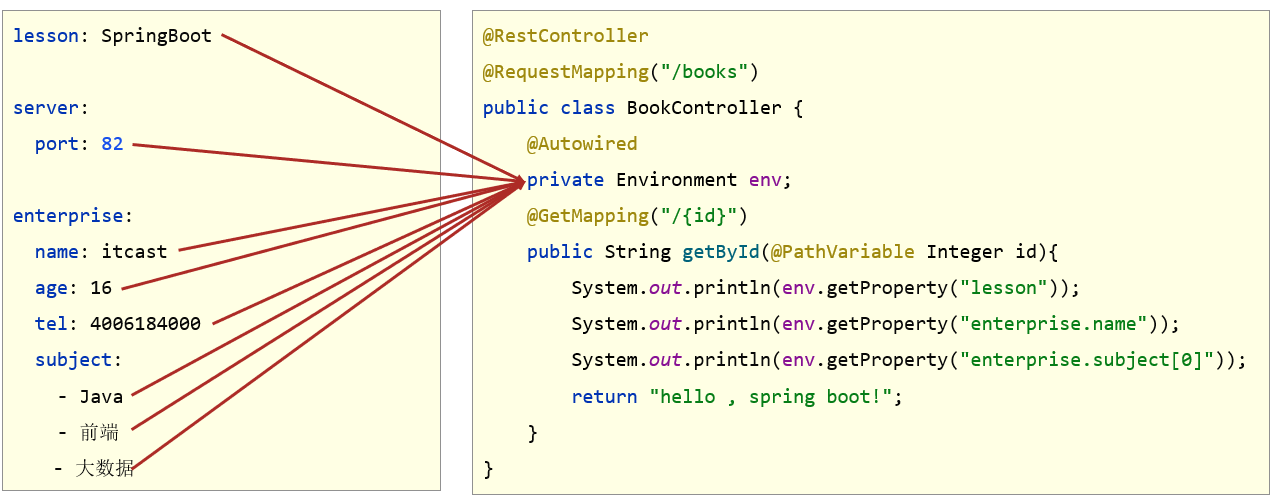 - **自定义对象封装指定数据【常用】** ```java public class Enterprise { private String name; private Integer age; private String tel; private String[] subject; //自行添加getter、setter、toString()等方法 } ``` 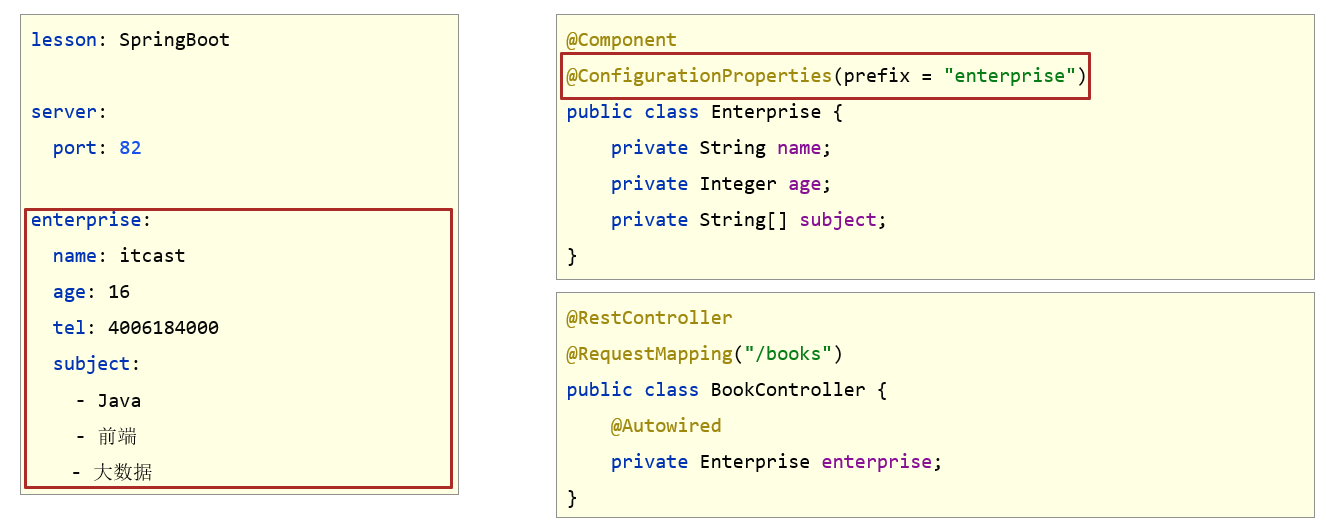 - 自定义对象封装数据警告解决方案  ```xml <dependency> <groupId>org.springframework.boot</groupId> <artifactId>spring-boot-configuration-processor</artifactId> <optional>true</optional> </dependency> ``` ### 3. 多环境开发配置 #### 问题导入 在实际开发中,项目的开发环境、测试环境、生产环境的配置信息是否会一致?如何快速切换? #### 3.1 多环境启动配置 - **yaml文件多环境启动** 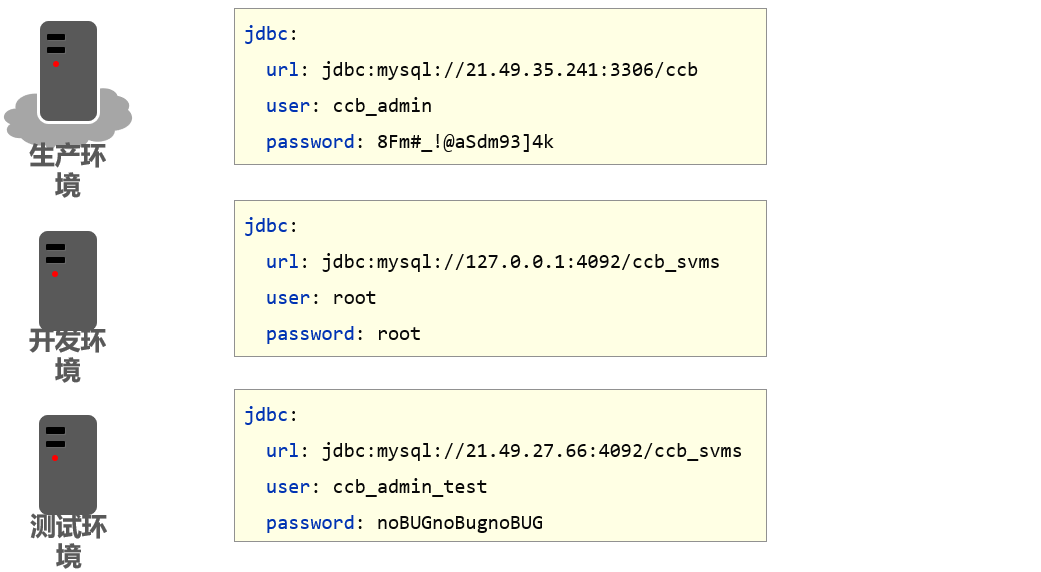 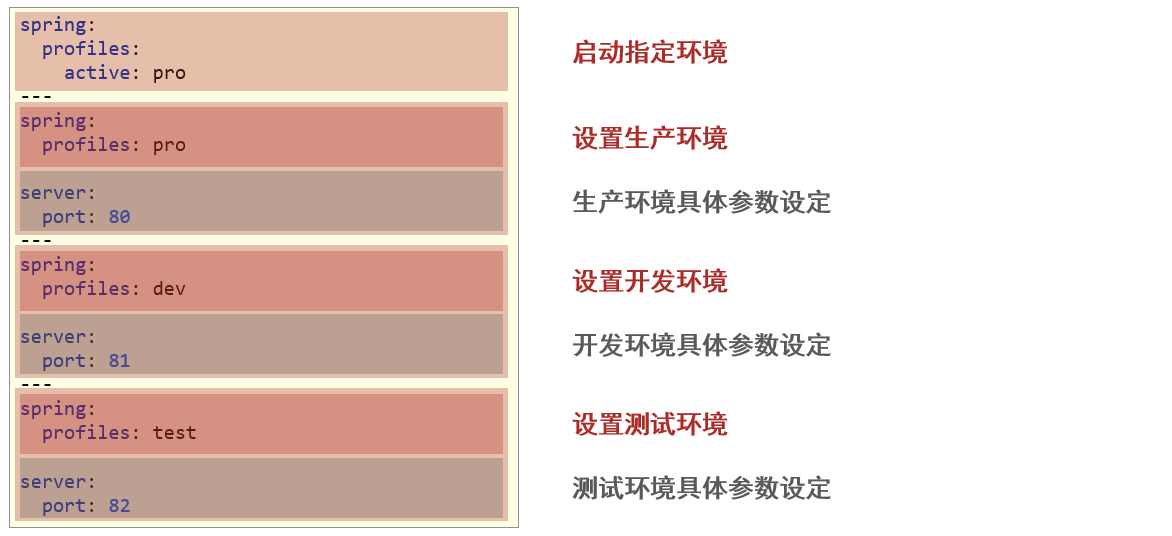  - **properties文件多环境启动** ```properties #主启动配置文件 application.properties spring.profiles.active=pro ``` ```properties #环境分类配置文件 application-pro.properties server.port=80 ``` ```properties #环境分类配置文件 application-dev.properties server.port=81 ``` ```properties #环境分类配置文件application-test.properties server.port=82 ``` #### 3.2 多环境启动命令格式 - 带参数启动SpringBoot ```properties java –jar springboot.jar --spring.profiles.active=test java –jar springboot.jar --server.port=88 java –jar springboot.jar --server.port=88 --spring.profiles.active=test ``` - 参数加载优先顺序 - 参看文档:[https://docs.spring.io/spring-boot/docs/current/reference/html/spring-boot-features.html#boot-features-external-config](https://docs.spring.io/spring-boot/docs/current/reference/html/spring-boot-features.html) 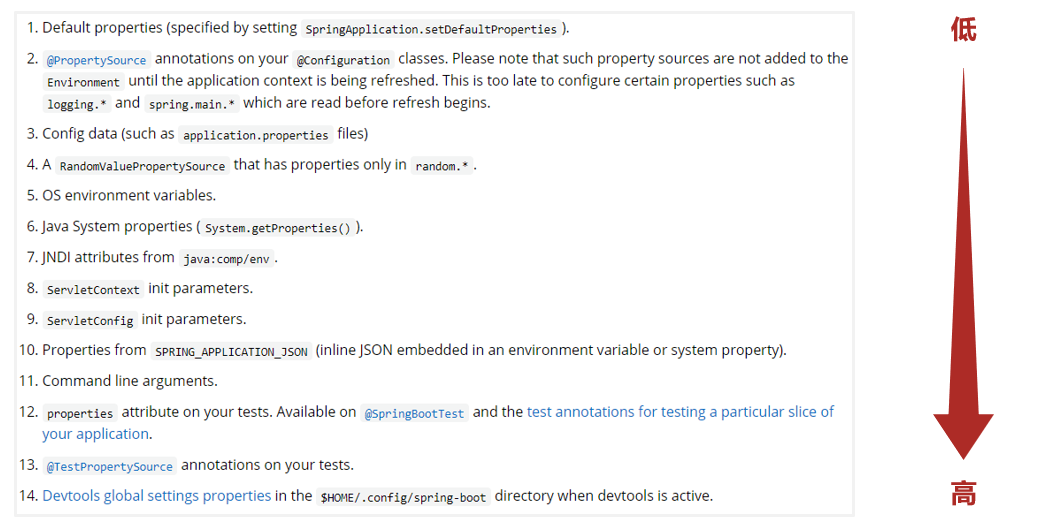 #### 3.3 多环境开发控制 **Maven与SpringBoot多环境兼容(步骤)** ①:Maven中设置多环境属性 ```xml <profiles> <profile> <id>dev_env</id> <properties> <profile.active>dev</profile.active> </properties> <activation> <activeByDefault>true</activeByDefault> </activation> </profile> <profile> <id>pro_env</id> <properties> <profile.active>pro</profile.active> </properties> </profile> <profile> <id>test_env</id> <properties> <profile.active>test</profile.active> </properties> </profile> </profiles> ``` ②:SpringBoot中引用Maven属性 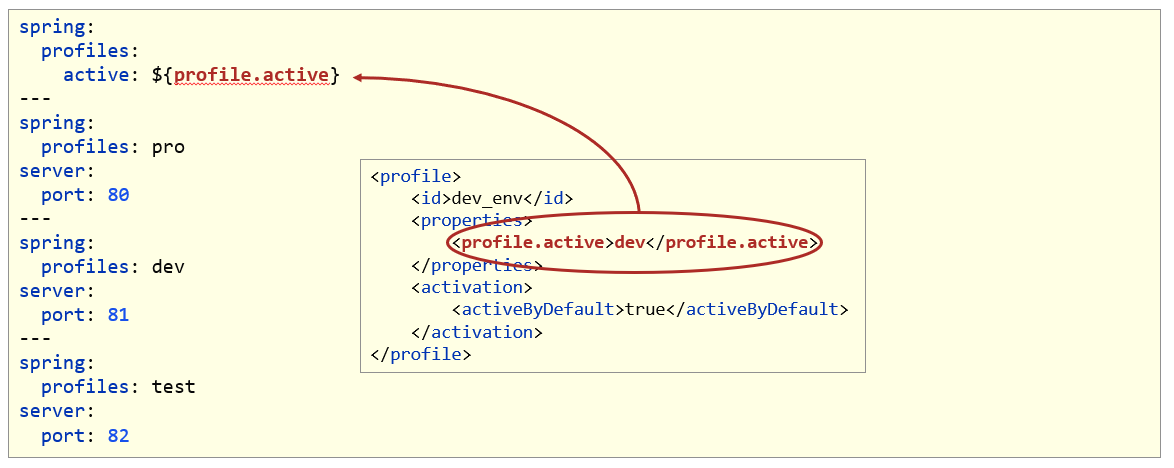 ③:执行Maven打包指令 - Maven指令执行完毕后,生成了对应的包,其中类参与编译,但是配置文件并没有编译,而是复制到包中  - 解决思路:对于源码中非java类的操作要求加载Maven对应的属性,解析${}占位符 ④:对资源文件开启对默认占位符的解析 ```xml <build> <plugins> <plugin> <artifactId>maven-resources-plugin</artifactId> <configuration> <encoding>utf-8</encoding> <useDefaultDelimiters>true</useDefaultDelimiters> </configuration> </plugin> </plugins> </build> ``` - Maven打包加载到属性,打包顺利通过  ### 4. 配置文件分类 #### 问题导入 SpringBoot的配置文件可以放在项目的哪些地方? 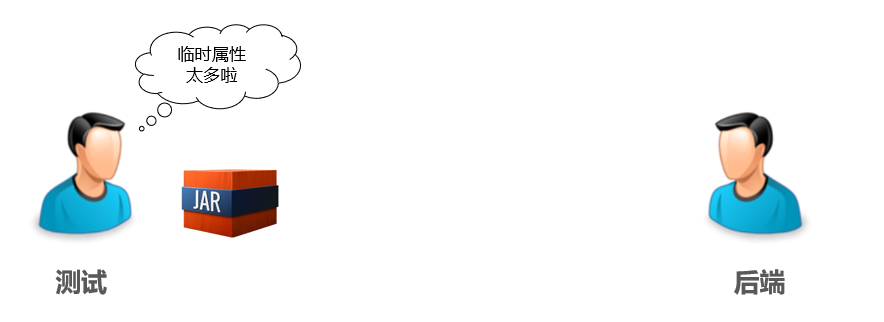 ```properties java –jar springboot.jar --spring.profiles.active=test --server.port=85 --server.servlet.context-path=/heima --server.tomcat.connection-timeout=-1 ... ... ``` - SpringBoot中4级配置文件 1级: file :config/application.yml 【最高】 2级: file :application.yml 3级:classpath:config/application.yml 4级:classpath:application.yml 【最低】 - 作用: 1级与2级留做系统打包后设置通用属性 3级与4级用于系统开发阶段设置通用属性 ## 三、整合第三方技术 ### 1. 整合JUnit #### 问题导入 回忆一下Spring整合JUnit的步骤? #### 1.1 Spring整合JUnit(复习) 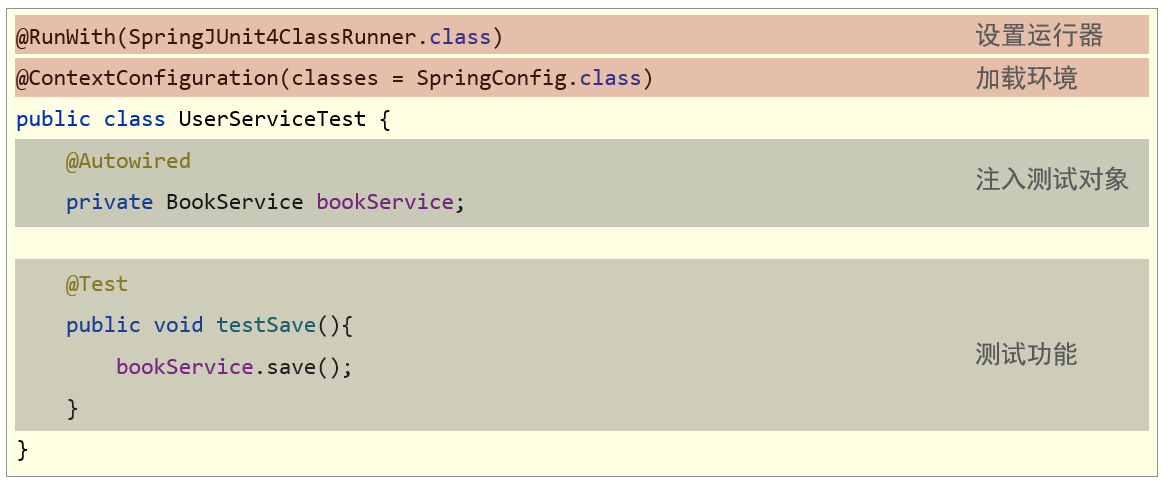 #### 1.2 SpringBoot整合JUnit 【第一步】添加整合junit起步依赖(可以直接勾选) ```xml <dependency> <groupId>org.springframework.boot</groupId> <artifactId>spring-boot-starter-test</artifactId> <scope>test</scope> </dependency> ``` 【第二步】编写测试类,默认自动生成了一个 ```java @SpringBootTest class Springboot07JunitApplicationTests { @Autowired private BookService bookService; @Test public void testSave() { bookService.save(); } } ``` ### 2. 基于SpringBoot实现SSM整合 #### 问题导入 回忆一下Spring整合MyBatis的核心思想? #### 2.1 Spring整合MyBatis(复习) - SpringConfig - 导入JdbcConfig - 导入MyBatisConfig ```java @Configuration @ComponentScan("com.itheima") @PropertySource("classpath:jdbc.properties") @Import({JdbcConfig.class, MyBatisConfig.class}) public class SpringConfig { } ``` - JDBCConfig - 定义数据源(加载properties配置项:driver、url、username、password) ```properties #jdbc.properties jdbc.driver=com.mysql.jdbc.Driver jdbc.url=jdbc:mysql://localhost:3306/spring_db jdbc.username=root jdbc.password=itheima ``` ```java public class JdbcConfig { @Value("${jdbc.driver}") private String driver; @Value("${jdbc.url}") private String url; @Value("${jdbc.username}") private String userName; @Value("${jdbc.password}") private String password; @Bean public DataSource getDataSource() { DruidDataSource ds = new DruidDataSource(); ds.setDriverClassName(driver); ds.setUrl(url); ds.setUsername(userName); ds.setPassword(password); return ds; } } ``` - MyBatisConfig - 定义SqlSessionFactoryBean - 定义映射配置 ```java @Bean public SqlSessionFactoryBean getSqlSessionFactoryBean(DataSource dataSource) { SqlSessionFactoryBean ssfb = new SqlSessionFactoryBean(); ssfb.setTypeAliasesPackage("com.itheima.domain"); ssfb.setDataSource(dataSource); return ssfb; } ``` ```java @Bean public MapperScannerConfigurer getMapperScannerConfigurer() { MapperScannerConfigurer msc = new MapperScannerConfigurer(); msc.setBasePackage("com.itheima.dao"); return msc; } ``` #### 2.2 SpringBoot整合MyBatis - SpringBoot整合Spring(不存在) - SpringBoot整合SpringMVC(不存在) - SpringBoot整合MyBatis(主要) ①:创建新模块,选择Spring初始化,并配置模块相关基础信息  ②:选择当前模块需要使用的技术集(MyBatis、MySQL) 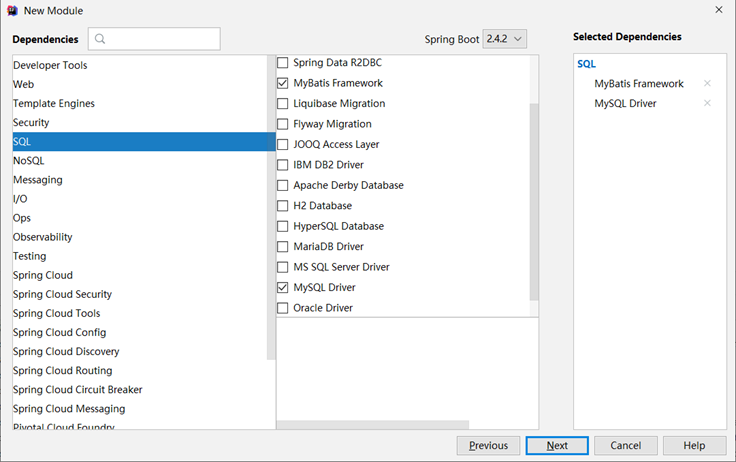 ③:设置数据源参数 ```yaml spring: datasource: driver-class-name: com.mysql.cj.jdbc.Driver url: jdbc:mysql://localhost:3306/ssm_db?serverTimezone=UTC username: root password: root type: com.alibaba.druid.pool.DruidDataSource ``` 注意事项: 1. SpringBoot版本低于2.4.3(不含),Mysql驱动版本大于8.0时,需要在url连接串中配置时区,或在MySQL数据库端配置时区解决此问题 ```properties jdbc:mysql://localhost:3306/ssm_db?serverTimezone=UTC ``` ④:定义数据层接口与映射配置 ```java @Mapper public interface UserDao { @Select("select * from tbl_book where id=#{id}") Book getById(Integer id); } ``` ⑤:测试类中注入dao接口,测试功能 ```java @SpringBootTest class Springboot08MybatisApplicationTests { @Autowired private BookDao bookDao; @Test public void testGetById() { Book book = bookDao.getById(1); System.out.println(book); } } ``` #### 2.3 案例-SpringBoot实现ssm整合 **【第一步】创建SpringBoot工程,添加druid依赖** ```xml <!-- todo 1 添加druid连接池依赖--> <dependency> <groupId>com.alibaba</groupId> <artifactId>druid</artifactId> <version>1.2.6</version> </dependency> ``` **【第二步】复制springmvc_11_page工程各种资源(主java类、页面、测试类)** **【第三步】删除config包中的所有配置,在BookDao接口上加@Mapper注解** ```java //todo 3 在BookDao接口上加@Mapper注解,让SpringBoot给接口创建代理对象 @Mapper public interface BookDao { //... } ``` **【第四步】将application.properties修改成application.yml,配置端口号和连接参数** ```yaml server: port: 80 # todo 4 配置数据库连接参数 spring: datasource: driver-class-name: com.mysql.cj.jdbc.Driver url: jdbc:mysql://localhost:3306/ssm_db username: root password: root type: com.alibaba.druid.pool.DruidDataSource ``` **【第五步】修改BookServiceTest配置类,进行配置** ```java // todo 5 修改单元测试类,添加@SpringBootTest主键,修复@Test注解导包 @SpringBootTest public class BookServiceTest { @Autowired private BookService bookService; @Test public void testGetById(){ Book book = bookService.getById(2); //传递参数1会抛出异常 System.out.println(book); } @Test public void testGetAll(){ List<Book> all = bookService.getAll(); System.out.println(all); } } ``` **【第六步】在static目录中提供index.html页面,跳转到"pages/books.html"** ```html <script> location.href="pages/books.html" </script> ``` **最后:运行引导类即可访问** 最后修改:2023 年 09 月 06 日 © 允许规范转载 打赏 赞赏作者 支付宝微信 赞 如果觉得我的文章对你有用,请随意赞赏